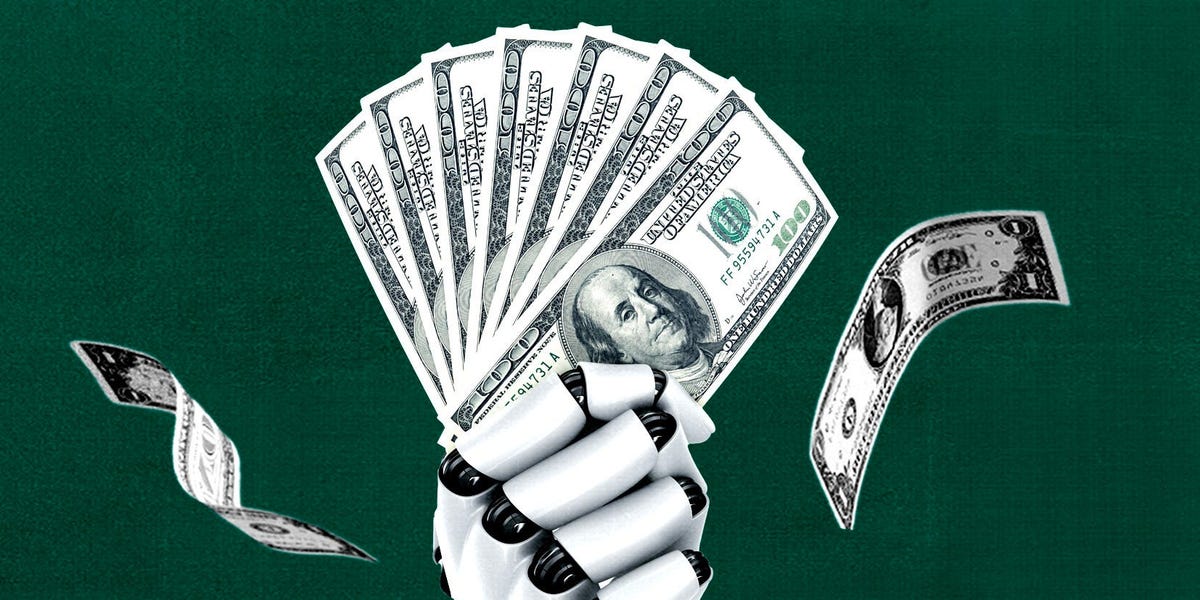
- AI infrastructure companies took off in 2024 as investors put their money in the picks and shovels.
- Goldman Sachs believes companies using AI to boost revenues will be next to take off in 2025.
- Here are 11 companies that are realizing revenue gains from the technology.
This year, the AI story has dominated the stock market.
Just seven stocks have fueled much of the market’s rally: Amazon, Apple, Alphabet, Microsoft, Meta, Nvidia, and Tesla. The Magnificent Seven have returned 148% since the end of 2022, drastically outperforming the 55% return for the rest of the S&P 500 index over that time. These tech behemoths have seen their earnings turbocharged by their market dominance in sectors such as cloud computing, software, and semiconductors.
AI infrastructure stocks have also started to take off. Data-center stocks like Vertiv and Digital Realty have soared as the demand to build out AI capacity has risen.
But now, so-called “Phase 3” AI stocks, which are rolling out the technology to increase their revenues, are set to shine, according to Goldman Sachs.
2025 will be the year of transition from investing in AI infrastructure to AI beneficiaries, Goldman’s Chief US Equity Strategist David Kostin said. Two years after the debut of ChatGPT, more and more revenue-generating use cases for AI are emerging.
“While Phase 2 stocks may continue to outperform the broad equity market, we expect returns will be earnings-driven and the risk/reward for new capital appears more attractive within Phase 3,” Kostin and his team wrote in a recent note.
Move over, Magnificent Seven
After an incredible two-year rally, it’s may be difficult to see the Magnificent Seven cooling off. The stocks have shown impressive earnings growth in the last year and have come to dominate the market, making up about 30% of the S&P 500 by market cap. However, the growth that placed them there isn’t sustainable for the long term, Kostin said.
That’s not to say that the Magnificent Seven aren’t solid companies. Goldman still expects them to outperform the rest of the index in 2025, but the bank is expecting them to do so by only 7%. For context, the Magnificent Seven outperformed the rest of the S&P 500 by 22% so far this year and 63% in 2023. Valuations for the market’s biggest performers are overripe: the Magnificent Seven trade at a forward price-to-earnings ratio of 30x, while the rest of the index trades at a modest 19x.
That’s where the AI Phase 3 trade comes in. These companies, whose revenues and earnings are set to get a boost from AI implementation, are valued much more reasonably, with the typical Phase 3 company trading at only 0.1 standard deviations more expensive than average, compared to 0.5 for Phase 2.
Valuations for Phase 3 stocks are depressed due to a recent decreased enthusiasm for AI, as some market experts have been questioning if AI is a trillion-dollar bubble ready to pop, according to Goldman Sachs.
Lower expectations for Phase 3 stocks isn’t necessarily a bad thing, though — it makes it easier for these companies to beat investor expectations and increase their share price. On the other hand, expectations for Nvidia have risen so high that the stock still fell in after-hours trading in the wake of consensus-beating Q3 revenue performance.
“The share price performance of the companies in the infrastructure basket has dramatically outpaced their trajectory of earnings growth,” Kostin said of Phase 2 companies. On the other hand, companies in the AI-enabled revenue group have seen share price growth in line with earnings growth. “And so our analysis is there’s potential for multiple expansion in those stocks,” Kostin added.
To find companies likely to see enhanced revenues from AI, Goldman Sachs analyzed recent messaging from company management regarding AI rollout. The bank identified the following 11 companies adopting AI to enhance their revenues as well as recent commentary from Q3 earnings calls indicating increased AI usage.






